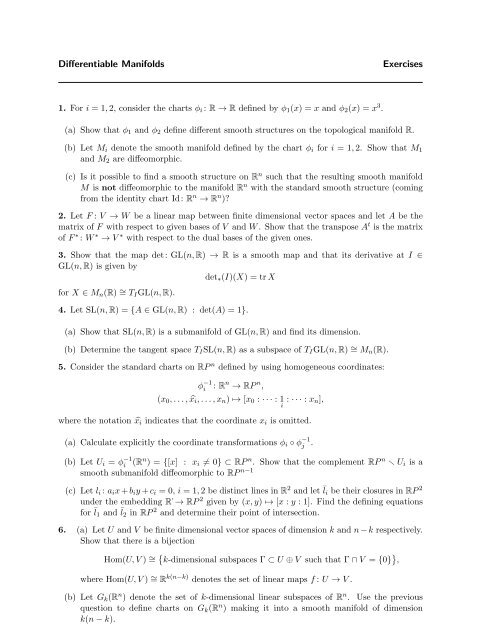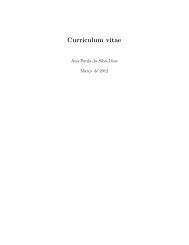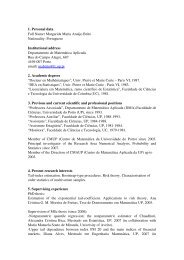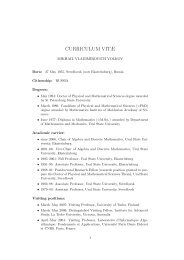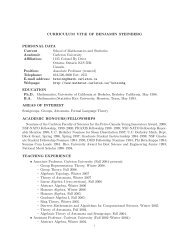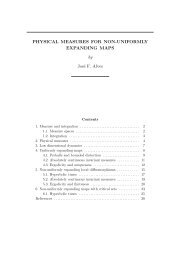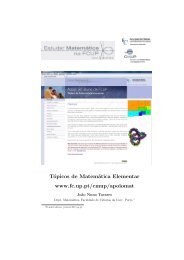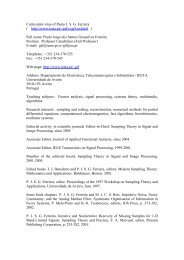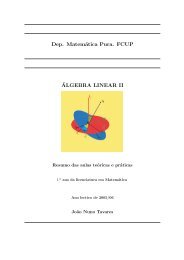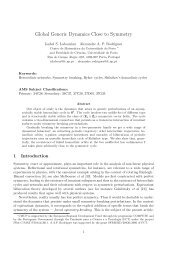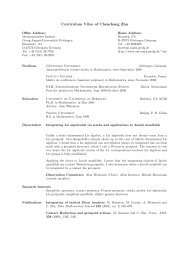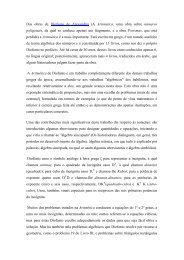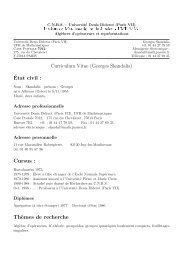Create successful ePaper yourself
Turn your PDF publications into a flip-book with our unique Google optimized e-Paper software.
Differentiable Manifolds<br />
Exercises<br />
1. For i = 1, 2, consider the charts φ i : R → R defined by φ 1 (x) = x and φ 2 (x) = x 3 .<br />
(a) Show that φ 1 and φ 2 define different smooth structures on the topological manifold R.<br />
(b) Let M i denote the smooth manifold defined by the chart φ i for i = 1, 2. Show that M 1<br />
and M 2 are diffeomorphic.<br />
(c) Is it possible to find a smooth structure on R n such that the resulting smooth manifold<br />
M is not diffeomorphic to the manifold R n with the standard smooth structure (coming<br />
from the identity chart Id: R n → R n )?<br />
2. Let F : V → W be a linear map between finite dimensional vector spaces and let A be the<br />
matrix of F with respect to given bases of V and W . Show that the transpose A t is the matrix<br />
of F ∗ : W ∗ → V ∗ with respect to the dual bases of the given ones.<br />
3. Show that the map det: GL(n, R) → R is a smooth map and that its derivative at I ∈<br />
GL(n, R) is given by<br />
det ∗ (I)(X) = tr X<br />
for X ∈ M n (R) ∼ = T I GL(n, R).<br />
4. Let SL(n, R) = {A ∈ GL(n, R) : det(A) = 1}.<br />
(a) Show that SL(n, R) is a submanifold of GL(n, R) and find its dimension.<br />
(b) Determine the tangent space T I SL(n, R) as a subspace of T I GL(n, R) ∼ = M n (R).<br />
5. Consider the standard charts on RP n defined by using homogeneous coordinates:<br />
φ −1<br />
i<br />
: R n → RP n ,<br />
(x 0 , . . . , ̂x i , . . . , x n ) ↦→ [x 0 : · · · : 1<br />
i<br />
: · · · : x n ],<br />
where the notation ̂x i indicates that the coordinate x i is omitted.<br />
(a) Calculate explicitly the coordinate transformations φ i ◦ φ −1<br />
j<br />
.<br />
(b) Let U i = φ −1<br />
i<br />
(R n ) = {[x] : x i ≠ 0} ⊂ RP n . Show that the complement RP n U i is a<br />
smooth submanifold diffeomorphic to RP n−1<br />
(c) Let l i : a i x + b i y + c i = 0, i = 1, 2 be distinct lines in R 2 and let ¯l i be their closures in RP 2<br />
under the embedding R ↩ → RP 2 given by (x, y) ↦→ [x : y : 1]. Find the defining equations<br />
for ¯l 1 and ¯l 2 in RP 2 and determine their point of intersection.<br />
6. (a) Let U and V be finite dimensional vector spaces of dimension k and n − k respectively.<br />
Show that there is a bijection<br />
Hom(U, V ) ∼ = { k-dimensional subspaces Γ ⊂ U ⊕ V such that Γ ∩ V = {0} } ,<br />
where Hom(U, V ) ∼ = R k(n−k) denotes the set of linear maps f : U → V .<br />
(b) Let G k (R n ) denote the set of k-dimensional linear subspaces of R n . Use the previous<br />
question to define charts on G k (R n ) making it into a smooth manifold of dimension<br />
k(n − k).
7. Let N ↩→ M be an embedding such that N is closed in M and let f : N → R be a smooth<br />
function. Show that there exists a smooth function g : M → R such that g |N = f.<br />
Hint: partition of unity.<br />
8. Let M be a smooth compact one-dimensional manifold. What can you say about it? How<br />
many examples of such manifolds can you come up with?<br />
9. Let X(M) the space of smooth vector fields on the manifold M and let Der(C ∞ (M)) be<br />
the space of derivations of the R-algebra C ∞ (M), i.e., R-linear maps D : C ∞ (M) → C ∞ (M)<br />
satisfying D(fg) = D(f)g + fD(g). Show that the map<br />
Ψ: X(M) → Der(C ∞ (M))<br />
defined by<br />
is an isomorphism.<br />
Ψ(X)(f) = X(f)<br />
10. Let U ⊂ R m be open and let X, Y ∈ X(U) be vector fields given by<br />
X = a i<br />
∂<br />
, a i ∈ C ∞ ∂<br />
(U) and Y = b i ,<br />
∂x i ∂x i<br />
b i ∈ C ∞ (U).<br />
Show that the bracket [X, Y ] ∈ X(U) is given by<br />
[X, Y ] =<br />
(<br />
)<br />
∂b j ∂a j<br />
a i − b i<br />
∂x i ∂x i<br />
∂<br />
∂x j<br />
.<br />
11. Let M be a smooth manifold and let X, Y ∈ X(M) be smooth vector fields. Show that<br />
for any smooth functions f, g ∈ C ∞ (M).<br />
[fX, gY ] = fg[X, Y ] + (fXg)Y − (gY f)X<br />
12. Consider the canonical identification of the tangent space of GL(n, R) at the identity with<br />
the space of all n × n-matrices:<br />
T I GL(n, R) = M n (R)<br />
and let [X, Y ] = XY − Y X be the commutator of matrices. Consider the linear map<br />
given by<br />
Ψ: T I GL(n, R) → X(GL(n, R))<br />
Ψ(X)(P ) = ˜X(P ) = P X<br />
for X ∈ T I GL(n, R) and P ∈ GL(n, R), and where P X denotes the product of matrices.<br />
Show that<br />
Ψ([X, Y ]) = [Ψ(X), Ψ(Y )]<br />
Hint: You may want to use the bracket of vector fields in local coordinates from above.<br />
Remark: Give T I GL(n, R) the Lie algebra structure from the commutator of matrices and give<br />
X(GL(n, R)) the Lie algebra structure from the bracket of vector fields. Then you are asked to<br />
show that Ψ is a homomorphism of Lie algebras.
13. Consider the chart φ on R 2 {0} given by (x, y) = φ −1 (r, θ) = (r cos θ, r sin θ) for (r, θ) ∈<br />
R + ×] − π, π[. Let ω ∈ Ω 1 (R 2 {0}) be given by<br />
ω(x, y) =<br />
−y dx + x dy<br />
x 2 + y 2 .<br />
Calculate the expression for ω in the local coordinates (r, θ).<br />
14. Let U ⊂ R 3 be open. Show that there is a commutative diagram<br />
C ∞ (U)<br />
⏐<br />
∇<br />
−−−−→ X(U)<br />
∇×<br />
−−−−→ X(U)<br />
∇·<br />
−−−−→ C ∞ (U)<br />
⏐<br />
↓φ 0<br />
⏐ ⏐↓<br />
φ 1<br />
⏐ ⏐↓<br />
φ 2<br />
⏐ ⏐↓<br />
φ 3<br />
Ω 0 (U)<br />
d<br />
−−−−→ Ω 1 (U)<br />
d<br />
−−−−→ Ω 2 (U)<br />
where the isomorphisms φ i , i = 0, 1, 2, 3 are defined by<br />
φ 0 = Id,<br />
φ 1 (f 1 , f 2 , f 3 ) = f 1 dx 1 + f 2 dx 2 + f 3 dx 3 ,<br />
d<br />
−−−−→ Ω 3 (U),<br />
φ 2 (g 1 , g 2 , g 3 ) = g 1 dx 2 ∧ dx 3 + g 2 dx 3 ∧ dx 1 + g 3 dx 1 ∧ dx 2 ,<br />
φ 3 (h) = h dx 1 ∧ dx 2 ∧ dx 3 .<br />
15. Let θ : U → V be a diffeomorphism between open sets U, V ⊂ R m . Let X ∈ X(U) be a<br />
vector field and write<br />
∂<br />
X = a i , a i ∈ C ∞ (U).<br />
∂x i<br />
Find the smooth functions b i ∈ C ∞ (V ) such that<br />
θ ∗ X = b j<br />
∂<br />
∂y j<br />
.<br />
16. Let θ : U → V be a diffeomorphism between open sets U, V ⊂ R m . Let ω ∈ Ω 1 (V ) be a<br />
1-form and write<br />
ω = a i dx i , a i ∈ C ∞ (V ).<br />
Find the smooth functions b i ∈ C ∞ (U) such that<br />
17. Let ω ∈ Ω 1 (R 2 {(0, 0)} be defined by<br />
ω(x, y) =<br />
θ ∗ ω = b j dx j .<br />
−y dx + x dy<br />
x 2 + y 2 ,<br />
and let f : R → R 2 be the smooth map f(t) = (cos t, sin t). Calculate the pull-back<br />
f ∗ ω ∈ Ω 1 (R).<br />
18. Consider the real projective space RP n with homogeneous coordinates<br />
and let, as usual,<br />
[x] = [x 0 : · · · : x n ] ∈ RP n<br />
U i = {[x 0 : · · · : x n ] ∈ RP n : x i ≠ 0}.<br />
Recall the definition of the tautological line bundle H p −→ RP n :<br />
Consider the trivializations<br />
H = {([x], v) ∈ RP n × R n+1<br />
φ i : U i × R → H |Ui = p −1 (U i )<br />
: ∃λ ∈ R such that v = λx}.<br />
([x], t) ↦→ ( [x], (t/x i ) · x ) .
(a) Find the corresponding transition functions g ij ([x]) for H.<br />
(b) Find the transition functions for the dual bundle H ∗ → RP n .<br />
(c) Find the transition functions for the tensor powers 1<br />
H ⊗k → RP n , k ∈ N.<br />
19. Let E → M and F → M be vector bundles with trivializations φ α for E and ψ α for F over<br />
open sets U α , such that {U α } is an open covering of M. Find transition functions which define<br />
a vector bundle Hom(E, F ) → M with the property that there is a natural identification<br />
Hom(E, F ) x<br />
∼ = Hom(Ex , F x ).<br />
20. Let H ⊥ → RP n be the rank n vector bundle defined by<br />
H ⊥ = {([x], w) ∈ RP n × R n+1 : 〈x, w〉 = 0}.<br />
(a) Show that the Whitney sum H ⊕ H ⊥ is isomorphic to the trivial vector bundle RP n ×<br />
R n+1 → RP n of rank n + 1 over RP n .<br />
(b) (Challenge!) Show that the tangent bundle T RP n is isomorphic to the vector bundle<br />
Hom(H, H ⊥ ).<br />
21. Let [a, b] ⊂ R be a closed interval. Let ω ∈ Ω 1 ([a, b]) be a smooth 1-form 2 : this can be<br />
written<br />
ω(t) = g(t)dt<br />
for some smooth function g on [a, b]. Define<br />
∫<br />
ω =<br />
[a,b]<br />
∫ b<br />
a<br />
g(t)dt.<br />
(a) Let r : [c, d] → [a, b] be a smooth map such that r(c) = a and r(d) = b. Calculate r ∗ ω and<br />
show that<br />
∫ ∫<br />
r ∗ ω = ω.<br />
[c,d]<br />
Let now M be a smooth manifold and let ω ∈ Ω 1 (M) be a smooth 1-form. For any smooth<br />
curve γ : [a, b] → M, define<br />
∫ ∫ b<br />
ω = γ ∗ ω.<br />
γ<br />
(b) Let ˜γ(s) = γ(r(s)) be a reparametrization of γ (where r is as above). Show that<br />
∫ ∫<br />
ω = ω.<br />
γ<br />
(c) Assume that ω = df for some smooth function f : M → R (we say that ω is exact). Show<br />
that<br />
∫<br />
ω = f(γ(b)) − f(γ(a)).<br />
[a, b].<br />
γ<br />
a<br />
˜γ<br />
[a,b]<br />
In particular, if γ is a closed curve, then ∫ γ<br />
df = 0.<br />
1 This <strong>exercise</strong> is for those who know tensor products.<br />
2 By this we mean that ω is the restriction to [a, b] of a smooth 1-form defined on some open interval containing
(d) Let ω ∈ Ω 1 (R 2 {(0, 0)}) be defined by<br />
ω(x, y) =<br />
−y dx + x dy<br />
x 2 + y 2 ,<br />
and let γ : [0, 2π] → R 2 {(0, 0)} be the curve γ(t) = (cos t, sin t). Calculate<br />
∫<br />
ω<br />
and deduce that ω is not exact.<br />
22. Let T 2 = S 1 × S 1 be the two-torus. Let<br />
U = T 2 (S 1 × {(0, 1)}),<br />
V = T 2 (S 1 × {(0, −1)}).<br />
Use the Mayer–Vietoris sequence for T 2 = U ∪ V to calculate the de Rham cohomology of T 2 .<br />
23. Let M be any smooth manifold of dimension m and let p ∈ M.<br />
(a) Show that there exists a smooth map<br />
γ<br />
f : M → S m<br />
which is a local diffeomorphism at p. Hint: Recall that the quotient space D m /∂D m is<br />
homeomorphic to S m , where D m ⊂ R m is the closed m-disk. Use a chart on M to first<br />
find a continuous map with the required property and then apply <strong>exercise</strong> 6.1 of Barden<br />
& Thomas.<br />
(b) Let f : M → S m be a smooth map as in (a) and let j : M {p} ↩→ M be the inclusion.<br />
Show that the composition<br />
is the zero map.<br />
j ∗ ◦ f ∗ : H m (S m ) → H m (M {p})<br />
(c) Let f : M → S m be a smooth map as in (a). If M is connected, show that<br />
is surjective. Deduce that<br />
is the zero map.<br />
f ∗ : H m (S m ) → H m (M)<br />
j ∗ : H m (M) → H m (M {p})<br />
(d) Let M be a connected smooth manifold and let p ∈ M. Let f : M → S m be a smooth<br />
map as in (a) and let U ⊂ M be an open neighbourhood of p diffeomorphic to an open<br />
disc in R m , such that f |U : U → S m is a diffeomorphism onto its image.<br />
Let V = M {p} and use the Mayer–Vietoris sequence for the covering M = U ∪ V to<br />
show that H m (M {p}) = 0.<br />
24. Let S g be a compact smooth oriented surface without boundary of genus g 0. Use an<br />
inductive argument based on the Mayer–Vietoris sequence and <strong>exercise</strong>s 6.4 and 6.5 of Barden<br />
& Thomas to calculate H ∗ (S g ).
25. Complex projective n-space is defined by<br />
CP n = (C n {0})/ ∼ where z ∼ w if z = λw for some λ ∈ C {0}.<br />
As for RP n , write [z] = [z 0 : · · · : z n ] for z = (z 0 , . . . , z n ) ∈ C n {0}.<br />
(a) Let U i = {[z] ∈ CP n<br />
: z i ≠ 0}. Show that the charts<br />
φ i : U i → C n<br />
[z 0 : · · · : z n ] ↦→ z z i<br />
make CP n into a compact connected oriented smooth manifold (use the standard identification<br />
C n ∼ = R 2n given by (z 1 , . . . , z n ) ↦→ (x 1 , y 1 , . . . , x n , y n ), where for z j = x j + iy j ,<br />
and the standard orientation dx 1 ∧ dy 1 ∧ · · · ∧ dx n ∧ dy n ).<br />
(b) Let V i := CP n {[0 : · · · : 0 : 1 : 0 · · · : 0]} . Show that the map (omitting the ith coordinate)<br />
is a homotopy equivalence.<br />
i<br />
V i → CP n−1<br />
[z] ↦→ [z 0 : · · · : ẑ i : · · · : z n ]<br />
(c) Use the Mayer–Vietoris sequence for the covering CP n = U n ∪V n to show that the inclusion<br />
induces an isomorphism<br />
j : CP n−1 ↩→ CP n<br />
[z 0 : · · · : z n−1 ] ↦→ [z 0 : · · · : z n−1 : 0]<br />
j ∗ : H k (CP n ) ∼ = −→ H k (CP n−1 ) for 1 < k < 2n − 1.<br />
(d) Show that H 2k (CP n ) ∼ = R and H 2k+1 (CP n ) ∼ = 0 for 0 k n.


